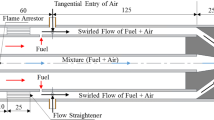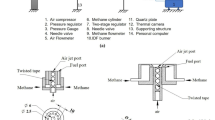Abstract
Detailed flow field and heat transfer characteristics developed in a row of three co-rotating dual swirling impinging flames have been investigated experimentally as well as numerically. Impingement heat transfer and pressure distribution has been studied experimentally at different separation distances and inter-jet spacings. Inverse heat conduction procedure (IHCP) has been used for estimating heat fluxes on the front side of impingement plate. Turbulence induced mixing results in strong interactions amongst adjacent flames causing deflections of inner flames of the burners situated at sides of central burner. Numerical simulation predicted formation of asymmetric recirculation zones for side flames. Symmetric interactions taking place for central flame produced two equal recirculation lobes for central flame. Behavior of central inner flame has been observed to be dependent on the value of inter-jet spacing used. Suppression of central inner flame tend to occur at higher inter-jet spacings due to recirculating products. Impingement pressure distribution is observed to be consistent with the heat flux distribution. Averaged heat fluxes registered at the impingement plate due to the central flame are higher in magnitude to those pertaining to each of the side flames.

























Similar content being viewed by others
Abbreviations
- d :
-
Diameter of inner pipe (mm)
- D i :
-
Inner diameter of outer pipe in the burner
- D o :
-
Outer diameter of outer pipe in the burner
- D h :
-
Hydraulic diameter (mm)
- h :
-
Convective heat transfer coefficient
- H, (H/D h ) :
-
Separation distance (non-dimensional)
- k :
-
Turbulent kinetic energy (m2/s2)
- M :
-
Molecular mass (kg/kmol)
- N :
-
Data point in thermal image
- p:
-
Pressure
- q″ :
-
Heat flux (kW/m2)
- \( {\overline{q}}^{{\prime\prime} } \) :
-
Averaged heat flux (kW/m2)
- r/D h :
-
Non-dimensional radial distance
- Re :
-
Reynolds number
- S, (S/D h ) :
-
Inter-jet spacing (non-dimensional)
- t :
-
Time
- T :
-
Temperature (K)
- T w :
-
Wall temperature (K)
- u m :
-
Mean velocity at burner exit
- u, v, w :
-
Velocity components in x, y and z direction
- X :
-
Mole fraction
- x, y :
-
Coordinate axis on impingement plate
- x/D h , y/D h :
-
Non-dimensional distances
- z :
-
Thickness (mm)
- Z :
-
Downstream distance from burner exit (mm)
- EDM:
-
Eddy dissipation model
- FPA:
-
Focal plane array
- IFOV:
-
Instantaneous field of view
- IHCP:
-
Inverse heat conduction procedure
- MFC:
-
Mass flow controllers
- RANS:
-
Reynolds averaged Navier Stokes
- RCZ:
-
Recirculation zone
- RJRC:
-
Radial jet reattachment combustion
- RNG:
-
Renormalization group theory
- α :
-
Thermal diffusivity (m2/s)
- ε :
-
Dissipation rate (m2/s3)
- λ :
-
Thermal conductivity (W/mK)
- μ :
-
Dynamic viscosity(kg/m s)
- ρ :
-
Density (kg/m3)
- Φ :
-
Equivalence ratio
- dev :
-
Deviation from averaged value
- dev, rms :
-
Root mean square deviation
- f :
-
Front side of impingement plate
- FJ :
-
Flame jet
- i :
-
Loop index
- ∞ :
-
Ambient
- j :
-
Index for chemical species
- r :
-
Rear side of impingement plate
References
Baukal CE, Gebhart B (1995) A review of flame impingement heat transfer – Part I: Experimental conditions. Combust Sci Technol 104:339–357
Baukal CE (1996) Heat transfer from flame impinging normal to a plane surface. Dissertation. University of Pennsylvania, Pennsylvania
Viskanta R (1993) Heat transfer to impinging isothermal gas and flame jets. Exp Thermal Fluid Sci 6:111–134
Martin H (1977) Heat and mass transfer between impinging gas jets and solid surfaces. Adv Heat Tran 13:1–60
Viskanta R (1991) Enhancement of heat transfer in industrial combustion systems: problem and future challenges. ASME / JSME Ther Engg. Joint Conference, New York
Huang XQ, Leung CW, Chan CK, Probert SD (2006) Thermal characteristics of a premixed impinging circular laminar-flame jet with induced swirl. Appl Energy 83(4):401–411
Zhen HS, Leung CW, Cheung CS (2009) Heat transfer from a turbulent swirling inverse diffusion flame to a flat surface. Int J Heat Mass Transf 52(11):2740–2748
Singh G, Chander S, Ray A (2012) Heat transfer characteristics of natural gas/air swirling flame impinging on a flat surface. Exp Thermal Fluid Sci 41:165–176
Hindasageri VK, Vedula RP, Prabhu SV (2015) Heat transfer distribution of swirling flame jet impinging on a flat plate using twisted tapes. Int J Heat Mass Transf 91:1128–1139
Luo DD, Zhen HS, Leung CW, Cheung CS (2010) Premixed flame impingement heat transfer with induced swirl. Int J Heat Mass Transf 53:4333–4336
Zhao Z, Yuen DW, Leung CW, Wong TT (2009) Thermal performance of a premixed impinging circular flame jet array with induced swirl. App Therm Engg 29(1):159–166
Zhen HS, Cheung CS, Leung CW, Li HB (2013) Thermal and heat transfer behaviour of an inverse diffusion flame with induced swirl. Fuel 103:212–219
Singh S, Chander S (2014) Heat transfer characteristics of dual flame with outer swirling and inner non-swirling flame impinging on a flat surface. Int J Heat Mass Transf 77:995–1007
Chen RH, Driscoll JF (1988) The role of the recirculation vortex in improving fuel-air mixing within swirling flames. Twenty-Second Symposium (Intl) on Combustion/The Combustion Institute, pp. 531–540
Katti VV, Yasaswy SN, Prabhu SV (2011) Local heat transfer distribution between smooth flat surface and impinging air jet from a circular nozzle at low Reynolds numbers. Heat Mass Transf 47(3):237–244
Remie MJ, Cremers MFG, Schreel KRAM, DeGoey LPH (2007) Analysis of the heat transfer of an impinging laminar flame jet. Int J Heat Mass Transf 50:2816–2827
Ashforth-Frost S, Jambunathan K, Whitney CF (1997) Velocity and turbulence characteristics of a semi-confined orthogonally impinging slot jet. Exp Thermal Fluid Sci 14:60–67
Dong LL, Cheung CS, Leung CW (2002) Heat transfer from an impinging pre-mixed butane/air slot flame jet. Int J Heat Mass Transf 45:979–992
Kwok LC, Cheung CS, Leung CW (2003) Heat transfer characteristics of slot and round pre-mixed impinging butane/air flame jet. Exp Heat Transfer 16:111–137
Goldstein RJ, Timmers JF (1982) Visualization of heat transfer from arrays of impinging jets. Int J Heat Mass Transf 25:1857–1868
Peper F, Leiner W, Fiebig M (1995) Drying performance and surface forces of a pair of impinging radial jets. Heat Mass Transf 30:313–320
Can M, Etemoglu AB, Avci A (2002) Experimental study of convective heat transfer under arrays of impinging air jets from slots and circular holes. Heat Mass Transf 38(3):251–259
Geers LFG, Tummers MJ, Hanjalic´ K (2004) Experimental investigation of impinging jet arrays. Exp Fluids 36:946–958
Aldabbagh LBY, Mohamad AA (2007) Effect of jet-to-plate spacing in laminar array jets impinging. Heat Mass Transf 43:265–273
Attalla M, Specht E (2009) Heat transfer characteristics from in-line arrays of free impinging jets. Heat Mass Transf 45(5):537–543
Etemoglu AB, Can M (2013) Performance studies of energy consumption for single and multiple nozzle systems under impinging air jets. Heat Mass Transf 49(8):1057–1070
Ozmen Y, Ipek G (2016) Investigation of flow structure and heat transfer characteristics in an array of impinging slot jets. Heat Mass Transf 52(4):773–787
Dong LL, Cheung CS, Leung CW (2003) Heat transfer of row of three butane/air flame jets impinging on a flat plate. Int J Heat Mass Transf 46:113–125
Kwok LC, Cheung CS, Leung CW (2005) Heat transfer characteristics of an array of impinging pre-mixed slot flame jets. Int J Heat Mass Transf 48:1727–1738
Chander S, Ray A (2007) Heat transfer characteristics of three interacting methane/air flame jets impinging on a flat surface. Int J Heat Mass Transf 50:640–653
Hindasageri VK, Vedula RP, Prabhu SV (2015) Heat transfer distribution for three interacting methane-air premixed impinging flame jets. Int J Heat Mass Transf 88:914–925
Wu J, Yagoobi JS, Page RH (2001) Heat transfer and combustion characteristics of an array of radial jet re-attachment flames. Combust Flame 125:955–964
Mohr JW, Yagoobi SJ, Page RH (1997) Heat transfer from a pair of radial jet reattachment flames. J Heat Transf 119:633–635
Dong LL, Cheung CS, Leung CW (2004) Heat transfer and wall pressure characteristics of twin premixed butane/air flame jets. Int J Heat Mass Transf 47:489–500
Zhen HS, Leung CW, Wong TT (2013) Improvement of domestic cooking flames by utilizing swirling flows. Fuel 119:153–156
Fu Y, Jeng SM (2007) Experimental investigation of swirling air flows in a multipoint LDI combustor. 43rd AIAA/ASME/SAE/ASEE Joint Propulsion Conference & Exhibit, Cincinnati
Cai J, Jeng SM, Tacina R (2002) Multi-swirler aerodynamics: comparison of different configurations. Proceedings of ASME Turbo Expo, Amsterdam, pp 1–10
Yang SL, Siow YK, Peschke BD, Tacina RR (2003) Numerical study of non-reacting gas turbine combustor swirl flow using Reynolds Stress Model. J Engg Gas Turbine and Power 125:804–811
Tacina KM, Lee CM, Wey C (2008) NASA Glenn high pressure low NOx emissions research, Paper No. NASA/TM−2008-214974
Diller TE (1993) Advances in Heat Flux Measurements. Adv Heat Tran 23:279–368
Nortershauser D, Millan P (2000) Resolution of a three-dimensional unsteady inverse problem by sequential method using parameter reduction and infrared thermography measurements. Numeri Heat Transf 37:587–611
Loubat R, Reulet P, Estebe B, Millan P (2004) Heat flux characterization in hot jet and flame/wall interaction by IHCP resolution coupled with infrared measurements. Quant IR Thermography J 1:205–228
Astarita T, Cardone G, Carlomagno GM (2006) Infrared thermography: An optical method in heat transfer and fluid flow visualisation. Opt Lasers Eng 44:261–281
Hindasageri VK, Vedula RP, Prabhu SV (2014) Heat transfer distribution for impinging methane-air premixed flame jets. App Thermal Engg 73:461–471
Wald AE, Salisbury JW (1995) Thermal infrared directional emissivity of powdered quartz. J Geophys Res 100:665–675
Beck JV, Blackwell B, St. Clair CR (1985) Inverse heat conduction Ill-posed problems. Wiley-Interscience, New York
Kline SJ, McClintock FA (1953) Describing uncertainties in single sample experiments. Mech Eng 75:3–8
ANSYS Inc. (2013) ANSYS Fluent Theory Guide. Release 15.0, Canonsburg
Acknowledgements
Authors sincerely acknowledge financial support received from Dr. B.R. Ambedkar National Institute of Technology Jalandhar for the execution of this experimental study. The author is also indebted to the faculty at Amrita Vishwa Vidyapeetham, Coimbatore, INDIA for their support and encouragement.
Author information
Authors and Affiliations
Corresponding author
Ethics declarations
Conflict statement
This is certified that there is no conflict of interest including any financial, personal or other relationships with other people or organizations within three years of beginning the submitted work that could inappropriately influence, or be perceived to influence, their work.
Additional information
Publisher’s note
Springer Nature remains neutral with regard to jurisdictional claims in published maps and institutional affiliations.
Rights and permissions
About this article
Cite this article
Singh, P., Velamati, R.K. & Chander, S. Experimental and computational analysis of a row of three co-swirling impinging flames. Heat Mass Transfer 56, 365–384 (2020). https://doi.org/10.1007/s00231-019-02706-x
Received:
Accepted:
Published:
Issue Date:
DOI: https://doi.org/10.1007/s00231-019-02706-x




